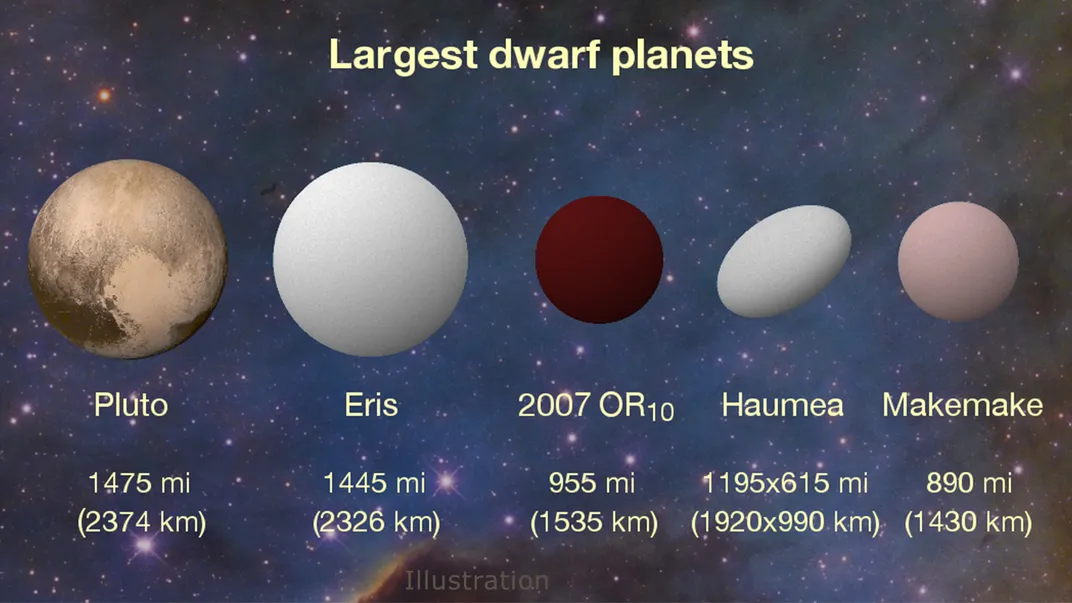The Largest Unnamed Object in the Solar System Needs a Title—and You Can Help
2007 OR10 needs a snazzier moniker; the public can now choose between ‘Gonggong,’ ‘Holle’ and ‘Vili’
A minor planet that lies beyond Neptune’s orbit has no name—much like a certain Game of Thrones character, if you will. In 2007, astronomers discovered the minor planet in the Kuiper belt, a “donut-shaped” region of icy objects, and the newly found world was designated 2007 OR10. Astronomers are now hoping to give OR10 a snazzier name. And, as Julia Jacobs reports for the New York Times, they are asking the public to help choose one.
International Astronomical Union (IAU) guidelines stipulate that all minor planets in the Kuiper belt with similar orbits must be given names associated with mythological creation figures. Accordingly, the astronomers who located OR10 have come up with three possible names for it: “Gonggong,” a Chinese water god who, in addition to creating chaos and causing floods, is known for tilting the Earth; “Holle,” a Germanic spirit of fertility and rebirth; and “Vili,” a Norse god who, along with his brothers Odin and Vé, conquers the giant Ymir and uses the body to create the universe. You can vote for your favorite selection until May 10.
Scientists behind the discovery of minor planets are usually given the opportunity to name them. But Meg Schwamb, an astronomer at Gemini Observatory in Hawaii who discovered OR10 along with Mike Brown and David Rabinowitz, tells Jacobs that she wanted to share the honor “with the rest of the world.”

OR10 is thought to be the largest celestial body in our solar system without an official name, but the researchers deliberately took their time in publicizing suggestions for a new moniker. “You can’t name something when you don’t know anything about it,” Schwamb tells New Scientist’s Leah Crane. Playing the long game proved the prudent choice. Brown, a professor of planetary astronomy at Caltech, revealed in a 2011 blog post that the researchers initially nicknamed OR10 “Snow White” because they assumed it would have “a nice bright white icy surface.” The team later discovered that the minor planet is in fact “one of the reddest objects ever found in the Kuiper belt.”
In the 12 years since its discovery, scientists have been able to piece together a more precise picture of OR10. It spans about 775 miles in diameter—about half the size of Pluto—and its body is likely made up of ice and rock. Its surface is covered with large amounts of pure water ice and possibly traces of methane ice, which may give OR10 its reddish hue; as Crane explains, sunlight turns red when it hits methane ice. The water ice on OR10’s surface is believed to stem from earlier activity by cryovolcanoes, which erupt with volatile compounds like ammonia, methane and water instead of lava.
In light of these attributes, the astronomers who discovered OR10 say they tried to choose possible names with links to the color red, ice and snow, or “a theme of inside turning outside.” Gonggong, for instance, has red hair. Holle is linked to the winter solstice and evergreen plants with red berries, and Vili is associated with Ymir, who was created from drops of water that formed when ice from the realm of Niflheim met heat from the realm of Muspelheim.
Researchers think OR10 is a dwarf planet, or a celestial body that “orbits the sun, has enough mass to assume a nearly round shape, has not cleared the neighborhood around its orbit and is not a moon,” according to NASA. But the IAU has not yet confirmed the designation. Final approval of OR10’s new name also rests with the IAU.
“We think there’s a good chance that the naming suggestion with the most votes will become the official name for 2007 OR10,” the astronomers write on the voting website. “If the top choice is not accepted, we will submit the second most popular choice to the IAU for consideration.”
The work won’t stop once OR10 has its official title. The minor planet has a moon, which, according to the researchers, will need a name too.

